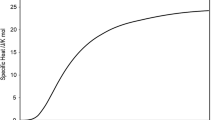Abstract
Platinum has a face-centered cubic crystal structure and does not have any phase changes between absolute zero and its melting point at 2045 K. High-purity platinum can be readily obtained in rod and sheet form and thus provides an excellent thermal expansion standard. Five investigations that used accurate and precise experimental techniques were used to establish analytical expressions for the coefficients of thermal expansion from 0 to 1800 K.
Similar content being viewed by others
References
G. K. White and M. L. Minges, CODATA Bulletin on Thermophysical Properties of Some Key Solids (Pergamon, Oxford, Dec. 1985), No. 59, p. 13.
R. J. Corruccini and J. J. Gniewek, National Bureau of Standards Monograph on Thermal Expansion of Technical Solids at Low Temperatures, No. 29, May 1961.
W. J. Campbell, Bureau of Mines Information Circular on Platinum Expansion Values for Thermal Calibration of High-Temperature X-Ray Diffraction Cameras and Diffractometers, IC 8107, 1962.
R. K. Kirby, T. A. Hahn, and B. D. Rothrock, in American Institute of Physics Handbook, 3rd ed. (AIP, New York, 1973), Chap. 4, p. 119.
Y. S. Touloukian, R. K. Kirby, R. E. Taylor, and P. D. Desai, in Thermophysical Properties of Matter. Vol. 12. Thermal Expansion (Plenum Press, New York, 1975), p. 254.
F. C. Nix and D. MacNair, Phys. Rev. 61:34 (1942).
J. Bockris, J. L. White, and J. D. MacKenzie, in Physicochemical Measurements at High Temperatures (Academic Press, New York, 1959), p. 344.
J. B. Austin, Physics 3:240 (1932).
L. Holborn and A. L. Day, Ann. Phys. 4:104 (1901); Am. J. Sci. 32(4):374 (1901).
E. A. Owen and E. L. Yates, Phil. Mag. 17:113 (1934).
H. Esser and H. Eusterbrock, Arch. Eisenhuttenw. 14:341 (1941).
J. W. Edwards, R. Speiser, and H. L. Johnston, J. Appl. Phys. 22(4):424 (1951).
H. G. Dorsey, Phys. Rev. 25:88 (1907).
V. A. Vertogradskii, Zavod. Lab. 35(4):515 (1969); Ind. Lab. USSR 35(4):619 (1969).
R. E. Edsinger, M. L. Reilly, and J. F. Schooley, J. Res. Natl. Bur. Stand. 91(6):333 (1986).
G. K. White, J. Phys. 2F(2):L30 (1972).
T. A. Hahn and R. K. Kirby, in Thermal Expansion-1971, M. G. Graham and H. E. Hagy, eds. (Am. Inst. Phys., New York, 1972), p. 87.
Additional information
Retired from the National Bureau of Standards, Gaithersburg, Maryland 20899, U.S.A.
Rights and permissions
About this article
Cite this article
Kirby, R.K. Platinum—A thermal expansion reference material. Int J Thermophys 12, 679–685 (1991). https://doi.org/10.1007/BF00534223
Issue Date:
DOI: https://doi.org/10.1007/BF00534223




